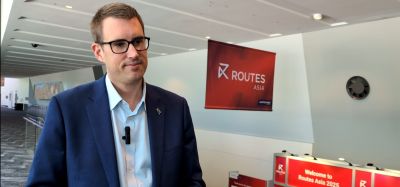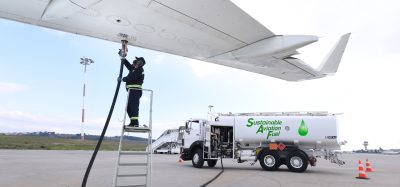Handling of military fuel grades with commercial filter monitors
- Like
- Digg
- Del
- Tumblr
- VKontakte
- Buffer
- Love This
- Odnoklassniki
- Meneame
- Blogger
- Amazon
- Yahoo Mail
- Gmail
- AOL
- Newsvine
- HackerNews
- Evernote
- MySpace
- Mail.ru
- Viadeo
- Line
- Comments
- Yummly
- SMS
- Viber
- Telegram
- Subscribe
- Skype
- Facebook Messenger
- Kakao
- LiveJournal
- Yammer
- Edgar
- Fintel
- Mix
- Instapaper
- Copy Link
Posted: 7 February 2009 | Pierre Poitras, Senior Chemist, Tactical Aerospace Fluids, Department of National Defence, Government of Canada | 2 comments
Aviation flight safety relies greatly on the provision of clean, dry and on-specification fuel types to airlines and military assets. Delivery of contaminant free fuel to aircraft relies on in-line filtration used throughout the fuel supply chain, including supplier’s terminals and airport facilities.
Aviation flight safety relies greatly on the provision of clean, dry and on-specification fuel types to airlines and military assets. Delivery of contaminant free fuel to aircraft relies on in-line filtration used throughout the fuel supply chain, including supplier’s terminals and airport facilities.
Over the years, much research in aviation fuel filtration systems has led to the development of several technologies, relying either on the principle of coalescence or water absorbance to remove particulate matter and free water from aviation turbine fuel. These filters elements must qualify to international standards and performance specifications set by the American Petroleum Institute (API) in the United States and the Energy Institute (EI) (former Institute of Petroleum (IP)) in the United Kingdom, namely API/IP 1581 standard and EI 1583 standard.
EI (IP) 1583 qualified filter elements are commonly called water absorbing elements or filter monitors, which contain a Super Absorbent Polymer (SAP) which is unique to its design. The polymer layer is intrinsic to the construction of the element, which permits the absorbance of free water that may be present in the fuel being delivered to an airport terminal or aircraft. There is great advantage to using qualified filter vessels which have such filter elements; smaller filter vessels and potentially higher flow rates, which is critical in providing timely refuelling to commercial airlines and military aircraft. These aviation fuel filter monitor elements, which contain water Super Absorbent Polymer (SAP), are commonly used at commercial facilities worldwide, either on refuelling vehicles or hydrant carts and also on military refuelling equipment.
The Canadian Forces (CF), as most NATO countries, employs F-34 aviation fuel type. This widely used fuel type contains military additives, such as fuel system icing inhibitor (FSII) and corrosion inhibitor as part of its additive package. The FSII additive inhibits the formation of ice crystals at low temperatures and is a critical part of flying operations. Only one product is qualified and approved by fuel specification; i.e. di-ethylene mono methyl glycol (DiEGME) used in jet fuel at 0.10-0.15% vol concentrations.
In recent years it has been determined that filter monitors qualified to IP 1583 4th edition, or earlier editions, cannot be regarded as fail-safe devices for preventing water being delivered to aircraft when used with military grade fuels containing Fuel System Icing Inhibitor (FSII). It has also become apparent that SAP, which has also been referred to in the military world as ‘Apple Jelly’ or ‘Shoe Shine’, can be formed from such elements and in exceptional circumstances can migrate downstream of the filtration system. This contamination was found downstream of the filter elements in the bottom of a filter vessel. These situations are unfortunate because these filters are great performers, using the most recent technology, and one advantage with filter monitors is other types of possible contaminants, such as surfactants, does not affect its water removal efficiency. Once captured, the water cannot be released. These cartridges also effectively filter out dirt, rust, and other particulates. As a cartridge reaches its water-holding limit, the media expands very rapidly and restricts the flow. The flow will eventually completely stop; giving positive shut-off to ensure water will not get downstream.
Filtration companies and the Energy Institute have conducted several studies, indicating that the performance of filter monitor elements can be significantly impaired when they are used in fuels containing FSII. In fact, the IP 1583 qualification testing is not meant to qualify filter elements subjected to fuel containing the FSII additive. The qualification test is meant to represent commercial grade fuel such as Jet A/A-1. The SAP in filter monitors may chemically react with the presence of water/FSII and be released downstream from filter monitor elements into the fuel. Potential SAP migration begins with the presence of water and DiEGME and the mixture reacts with its environment, extracting and dissolving compounds from the materials with which it comes into contact. All aviation fuel filter monitor manufacturers providing these elements qualified to IP 1583 4th edition, have stated that they cannot guarantee that quantities of SAP is not released in the fuel stream, including systems used in the civilian industry. All size and flow formats of filter monitors are implicated, but the extent of migration from them may vary. After the experience with FSII in military applications, International Air Transport Association (IATA) decided to evaluate if there were any concerns with commercial fuels, as water absorbing cartridges are used extensively in commercial operations. The study revealed that SAP migration is insignificant with commercial jet fuel and that no commercial incidents have been reported due to SAP contamination.
These filters have been used by the military world for more than 25 years with hardly any reported fuel contamination issues, but in recent years there have been some localised incidents of SAP migration. The common thread to these reported incidents was the use of super absorbent filter monitors in contact with water/FSII with F-34 fuel grade. These incidents are attributable to particular fuelling conditions, taking into account fuel flow rate; temperature, along with the obvious presence of excessive free water/FSII in the fuel stream. These situations can occur during steady state operations at Wings and military bases but are more likely to occur during deployed operations, where fuel quality and working conditions are les than optimal.
This issue of possible SAP migration, due to exposure to FSII/water phase, has been known for some time. In the late 90’s, filter manufacturers began issuing warnings on the fuse monitors when used with FSII additised fuel. Warnings from filter companies have been promulgated:
****CAUTION****
In fuels containing anti-icing additive (Di-E GME, FSII, Prist®), stagnant water bottoms can absorb large amounts of the anti-icing additive. This water/FSII solution can disarm water-absorbing elements allowing water to pass downstrea. Daily draining of the monitor vessell and of water bottoms upstream of the elements is IMPERATIVE. Also, changeout @ 15 psid.
Source: Velcon for the Aquacon filter units
Consequences of SAP Migration
As stated previously, the common factor for all activities reporting premature filter element failure is the high concentration of DiEGME in the water bottoms. The gel-like material observed by the field personnel is not stable and in time disappears or liquefies. This gel is most likely the result of the formation of a fuel-water-sediment emulsion combined with the effects of the high concentration of the DiEGME additive. The high concentration of DiEGME will degrade fuel system elastomeric materials and element materials. The resultant dissolved or tacky material may also combine with the emulsion, or contribute to the appearance of the gel-like substance. The dissolved or tacky material will certainly result in element restriction and premature failure of the elements. The chemical attack or degradation of the fuel system and filter element materials can be eliminated or greatly reduced by following established quality control and system maintenance procedures; e.g., eliminate significant accumulations of water by stripping tanks and routinely draining low points).
The worst-case scenario would have this material migrating in an aircraft fuel system and affecting aircraft/engine performance. If produced and present in sufficient quantities it can clog aircraft fuel filters and result in inadequate fuel pressure, fuel pump failure, engine starvation and force an aircraft to operate in bypass mode.
Canadian Forces Action Plan
Following a formal risk assessment in 2007, the CF have decided to remove filter monitor elements from it’s refuelling assets to rely mainly on coalescence principle provided by filter water separators qualified to API/IP 1581 standard.
To mitigate the use of IP 1583 filter monitors elements while the CF is converting their fuelling assets, the following actions and recommendations were instituted:
- Until replacement elements are available, always operate filtration system containing filter monitors in strict accordance with manufacturer’s instructions
- Do not use filter monitors where any free water in aviation fuel may contain high concentrations of salts or FSII
- In cases of uncertainty, seek assurance from the technical authority who can engage the filter monitor manufacturer to confirm that current filter monitors will be replaced by acceptable substitute filters in all CF mobile refuellers
- Filter monitor elements qualified to IP 1583 4th edition or earlier editions should not be solely relied upon to ensure that water in fuel is prevented from passing onto aircraft. The CF employs either multi-stage filtration systems or single stage in its mobile refuellers and it is critical that filtration systems upstream of these filter vessels be maintained diligently, to ensure SAP in filter monitors are not exposed to water
- Ensure that where a filter monitor is used, it forms only one part of a comprehensive system to control dirt and water in aviation fuel. A comprehensive system includes housekeeping procedures and quality assurance procedures. Good housekeeping is all encompassing and includes daily water draw offs, delta pressure checks, and maintenance of housing assemblies and other vehicle equipment, as well as the daily quality assurance testing.
Recommendations
As previously stated, the Canadian Forces have not yet had an incident resulting from the SAP migration phenomenon. The probability and likelihood of its occurrence is considered low. We attribute this to the fact that we are very diligent about having clean dry fuel. To this point, the actions stated previously have allowed the users to become aware of the problem and to take steps to mitigate the possibility of the occurrence. In addition to those actions already mentioned, asking that filter monitors be sent for evaluation on change out from inspection has increased the confidence level. This is to assess the extent, if any, of SAP media migration. With this knowledge the CF have been able to assess the depth of the problem within our refuelling fleet, using this technology to assure all measures to mitigate this risk were being accomplished. The CF plan to have these filters removed and replaced by the end of 2009.
While the military is working at introducing replacement systems, commercial airport operators should be made aware of this situation and should be cautious when requested to defuel military aircraft operating with F-34 fuel into commercial equipment using IP 1583 filter monitor elements. Often, defuelled fuel contains free water and coming from a military aircraft it would most likely contain FSII. Also, note that water bottoms containing FSII must be disposed of according to local environmental legislation due to its eco-toxicity.
It is essential that commercial locations and operatives be cognisant of this phenomenon, especially if the fuel is pre-blended with FSII, hence choosing a filtration system compatible with the fuel type being handled.
In the Canadian Forces, flight safety is paramount and strict aviation policy and procedures have been implemented to prevent contaminating the fuel being served to our operators, allies and transient aircraft. Upgrading and optimising the fuel supply chain is often a challenge, but must be prioritised for obvious reasons.
The aviation fuel industry has come a long way to standardise fuelling equipment and practices, and in recent years great efforts were made to harmonise fuel handling protocols between the commercial and military world as much as possible.


















Very nice article… so what about the use of military style filters on commercial grade fuel. Jet A-1 without FSII… can military grade filters be used for commercial purposes long term? I mean the filtration works the same but there is no FSII?
Please see EI advice 27th Nov2017 that Filter monitors shall be phased out of all aviation fuel handling systems. This is due to incidents of SAP migration, including Cathay Pacific Flight CX780 in April 2010. There is a new technology, as per EI 1588 1st Edition May 2018, AVIATION FUEL WATER BARRIER FILTERS. I don’t know what military style/grade filters are or there difference to commercial FWS EI 1581,or this new Barrier Filter, but EI 1581 test fluid includes FSII and Parker Velcon state for Barrier technology “testing has shown that the barrier material is effective for fuel with DiEGME ( FSII ) and suitable for Category M fuel “. Filter monitors with SAP are phased out, and EI1583 withdrawn by 31st Dec2020, so the issue of FSII and SAP, highlighted in the article, will disappear.